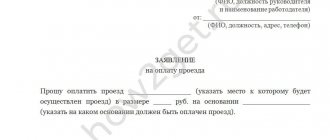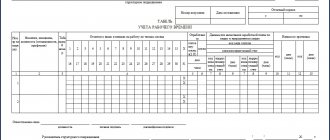In order for an employee to go on vacation, it is necessary to prepare a corresponding order. At the same time, one should not assume that after preparing it and transferring payments to the employee, one can forget about the order: such documentation must be kept for no less than the established period.
If you need advice on preparing and storing vacation orders, you can always seek help from a specialist. Timely legal support will help to avoid mistakes and claims from regulatory authorities.
How are the storage periods for documents regulated?
The deadlines are regulated by the following regulations:
- Law on Archival Affairs No. 125 of October 22, 2004;
- order of Rosarkhiv No. 236 dated December 20, 2019;
- order of Rosarkhiv No. 237 dated December 20, 2019.
These acts establish the storage periods for notices of the start of vacation, other personnel and other forms of the enterprise. Individual organizations (JSCs, medical institutions, banking organizations, etc.) should take into account the norms of industry legislation.
ConsultantPlus experts analyzed when and how to apply for annual paid leave for an employee. Use these instructions for free.
Formation of orders for personnel
Orders on personnel should be grouped into files based on their storage periods; however, it is not allowed to place documents of long-term storage (i.e. > 10 years) and temporary periods < 10 years together (in one file). For example, orders for admission, dismissal, etc. with a storage period of 75 years should be placed separately from orders for annual leave and business trips, which are stored for 5 years.
In this case, orders with the same storage period are allowed to be further divided into separate cases to facilitate their search in the future (especially with a large document flow). For example, orders on annual leave may constitute a separate file, and orders on business trips – another, although they all have a five-year retention period.
I would like to remind you once again that each independent matter must be included in the organization’s list of affairs.
If there is an appendix to an order, they are formed together - first the order, then the appendix.
At the same time, the grounds for orders regarding personnel are placed separately from them. The basis for orders may be:
As a rule, if in the current office work orders and the grounds for them were jointly formed, then in the process of preparation for archival storage such cases are reorganized to separate them. The grounds for orders with a shelf life of 75 years (for example, an employee’s application for admission, relocation, etc.) are usually included in the employee’s corresponding personal file.
The grounds for orders with short storage periods (for example, 5 years) can be formed separately from them, for which the nomenclature can include a case with an approximate title: “Documents that are not included in personal files (and their main types must be listed in brackets) "
When forming cases, it is necessary to check the correctness of registration: the presence of a signature, visas, date and order number. Unfinished orders are not allowed to be filed into files.
How much and where to store applications
All companies and entrepreneurs must keep documents generated in the course of business activities. The law regulates the storage periods for orders for annual leave and its other types, depending on working conditions:
- five years for standard conditions;
- fifty for harmful or hazardous conditions.
Besides:
- statements are kept for fifty years when they are included in a personal file;
- seventy-five - all statements written before 01/01/2003 and if they are included in the employee’s personal file.
The period is calculated from January 1 of the year following the year in which the document was completed by office work (Part 1 of Article 17, Article 21.1, Part 1, 2 of Article 22.1 of Federal Law No. 125, Articles 434, 435 of Order No. 236) .
You have the right to determine for yourself whether to include them in your personal file or not in a local regulatory act, taking into account Parts 1, 4 of Art. 8, part 1 art. 22 Labor Code of the Russian Federation.
There are no differences in the storage periods for applications for leave without pay (unpaid), for annual and additional ones - all these documents are stored in accordance with the general rules indicated above.
Local regulations (charter, regulations on document storage, etc.) determine where employee leave applications are stored: in the organization’s archives, in a warehouse, in separate folders or in a personal file. The archive is created in a separate office or in the HR department office. Usually, documents are filed (if they are not part of a personal file), a folder of employee statements for the year is created and submitted to the organization’s archives. You can delimit folders and determine where to store applications for unpaid leave, maternity leave, additional leave, etc.
Organizing the storage of personnel documents: nuances
Let us now consider the features of organizing the storage of personnel documentation. One of the key tasks of a competent specialist here is the formation of cases. When solving this problem, it is important to develop, first of all, a list of storage periods for documents belonging to certain groups. Each source must have the necessary details. If a document does not meet the established requirements, then it is not advisable to include it in the file.
When organizing the storage of personnel documents, the responsible employee can use various standard lists of information about relevant sources or use internal corporate standards.
Above we gave examples of documents that can be stored for 5 years (in particular, these include vacation orders), as well as those that the organization is obliged to place in archives for a significantly longer period. The circulation of sources of the second type may be regulated by additional internal regulations. So, if a document needs to be stored for 75 years, the enterprise can put into effect rules according to which personnel documentation is transferred to the archive for long-term placement. In turn, documents with a 5-year storage period in many cases do not need to be transferred to the archive. They can be placed in another protected place, but at the same time more accessible for prompt review of the relevant documents.
An important element of personnel document flow is the inventory. In particular, companies can use them when transferring cases to the organization’s archive.
It will be useful to consider the sequence of actions of a human resources specialist when preparing documents for leave.
How long should vacation orders be kept?
They are kept for the same amount of time as statements, depending on the category of the employee, inclusion in the personal file and the date of preparation. At the same time, there is no difference in how long an order for additional leave, for annual leave, etc. is kept. If the order is drawn up for a standard employee (not working in harmful or dangerous working conditions), the document is not included in the personal file and was drawn up after 01/01/2003, the storage period is five years.
The requirement for where employee leave orders are stored is contained in local regulations. The organization independently determines the place and method of storage. If there are few employees, it is not necessary to file folders annually - archive the filed folders for several years.
ConsultantPlus experts analyzed how long to store documents in an organization in 2021. Use these instructions for free.
Orders for personnel - their formation and storage
Orders for personnel are grouped into a separate file, and have their own numbering (different from orders for main activities). Within the file, documents are systematized according to the chronology of their creation.
Some types of orders for personnel are usually issued in a unified form. In this case, you just need to fill in the appropriate fields. The rest are compiled in free form, but at the same time it is necessary to adhere to certain requirements. If an order is drawn up in a non-unified form, the same recommendations are applied as for drawing up an order for the main activity.
Storage period for annual leave orders in 2021
Prompt storage of orders for annual leave is carried out directly in the structural unit. The organization is carried out in such a way that access to cases is free, and the search for the right source is simplified. In addition, only authorized employees with a business need are granted direct access.
Distribution into folders is carried out according to various criteria, in the first place is the shelf life by type. Inside the folder, it is convenient to organize sources by last names of employees and year of publication.
In large organizations, annual leave orders take up a large share of the HR document flow, so a filing system is needed. When forming a file of more than 250 sheets, it is divided into volumes, which are distributed in alphabetical order. Divided into several folders.
Folders with orders for daily leave must be marked on the covers. The letters that indicate each document in the file are indicated, as well as the date of creation and registration number of the first and last source. This identifying information on the cover allows you to quickly find the document you need inside the folder.
Documents on the basis of which orders for annual leave are created are sent for storage separately.
Retention periods for resignation letters
Personal files of employees are a mandatory element of documentation in state and municipal organizations, therefore officials whose powers include the preparation of documentation are required to comply with government regulations and rules for the safety of personal information about employees. However, this procedure is not mandatory for private entrepreneurs. Accordingly, every HR department manager is required to know exactly how many years employees’ personal files are kept after dismissal.
Procedure for registration and storage period of personal files
The procedure for registering a personal record must begin with enrollment in the organization's staff. Acquisition continues during work and lasts until dismissal with further transfer to archival institutions.
Individual acts can be placed in a separate file. The possibility of loss is prevented by packaging according to uniform rules, as well as by keeping a log.
At the time of registration, it is worth considering the following nuances:
- The title page displays complete information about employees: initials, registration date;
- The vault containing originals for temporary preservation should not contain permanent samples;
- Each document can be presented in a single version;
- It is not recommended to keep originals for permanent maintenance, since such papers can be replaced by copies;
- Each individual file may not exceed 4 cm in thickness and may not contain more than 250 pages.
According to current standards in the labor field, the residence time of papers and registration journals, individual cards and employment contracts is on average seventy-five years.
personal file
The case must consist of a cover and originals, which contains complete information about the employee and the nature of his work activity and training. The cover contains data that allows you to identify the employee at the time of the search, as well as the company, if the folders are subsequently handed over to the state archive.
The title page contains space for leaving archival stamps. Below is the name of the company in full and abbreviated versions.
Then the name of the department in which the employee holds a certain position is written down. The HR department employee is required to leave a blank line, which will be filled in in the event of a transfer to another department.
The cover must include the employee's initials and number.
In the lower right corner, enter the date of recruitment of personnel to the work position and the moment of dismissal. The number of sheets in the folder and the optimal duration of its presence after transfer to an archival institution should be clarified. Employees' personal files must contain the following documents:
- An application drawn up by an employee at the time of enrollment in a specific position;
- Copies of internal passport, individual tax number, health insurance policy);
- Characteristics compiled by previous employers;
- Employment contract;
- Job descriptions developed in accordance with the specifics of job duties;
- Summary;
- Copies of originals confirming educational level and professional qualifications;
- Internal papers of the enterprise;
- Originals indicating the fact of certification.
Employee documents contain a form with a detailed description of all samples placed in the folder.
Personnel records management: storage and destruction rules
The most important area of office work is the storage and use of originals. Papers must be kept in the archives of the enterprise. The procedure for storing papers is regulated by separate legislation. Accordingly, the employer guarantees employees the safety and confidentiality of the information provided in the folder.
The destruction of personal information is carried out in accordance with state requirements developed in the field of archives. Documents whose storage period has already expired are subject to destruction. Documentation for further destruction is selected by a responsible expert commission, which acts in accordance with the act of allocating papers for destruction.
Folders that are subject to destruction are transferred for further disposal. All samples are packaged and sealed before delivery. The transfer is formalized in accordance with the corresponding invoice, which must accurately indicate the date of receipt, the number of folders and the total weight of the waste paper.
Accounting and registration: entering other data
The accounting procedure is regulated by legislative standards in the labor sphere. Accordingly, they are stored and registered in the personnel department in a certain order. For convenience, a magazine is used, the form of which is determined by job descriptions. At the time of registration, the following information must be entered in the journal:
- Registration number;
- First name, last name and patronymic of the employee;
- Date of registration;
- A note on deregistration of the enterprise.
The moment of registration of the organization is the date of recording in the registration book.
In the field of office work, in the direction of storing and registering files, it is possible to make changes to folders with personal files.
Such changes should be recorded at the time of marriage, change of place of residence, advanced training or transfer to a workplace in another department of the organization.
To make changes, the employee himself contacts the personnel department of the enterprise, after which the head of the archive is called upon to record all changes. The general procedure for entering data is determined by compliance with the following algorithm:
- Providing a statement from staff requesting changes to the documentation, as well as submitting supporting documentation. Data can be changed only if there are significant circumstances;
- Issuing an order on the need to introduce innovations into accounting documentation;
- Registration of an order in the journal for recording orders that apply to personnel;
- Direct recording of information.
Thus, the preparation and registration of documentation, the procedure for storing and destroying personal files of enterprises are regulated by state legislation.
Retention periods for personnel documents
When putting things in order in personnel records , in the personnel documentation of the organization, be careful about the destruction of documents on personnel.
The storage periods for personnel documents are defined in the list of standard management documents accompanying the activities of organizations, indicating storage periods.
The list of personnel documents is intended for use as the main regulatory document when determining storage periods, and selecting standard management documents for storage and destruction.
Below are the storage periods for documents in personnel records . These terms are related to the hiring, relocation and dismissal of employees.
In personnel records , employment contracts, orders for admission, transfer, dismissal, personal cards, personal accounts of employees, personal files and registration forms for these documents have a shelf life of 75 years.
Unclaimed work books, a book of records of work books and inserts for them, in personnel records for 50 years.
The storage periods for personnel documents are established in personnel records by a list of typical management documents accompanying the activities of organizations, taking into account the storage periods.
All specified documents must be submitted to the personnel archive. The personal files of dismissed employees are transferred to archival storage for 75 years. The personal files of the company's managers are stored permanently in personnel records .
Temporary retention periods are used in personnel records by all organizations without exception.
Permanent storage periods are applied by state and municipal institutions, the documents of which are received for storage in the relevant archives, as well as by non-governmental organizations, taking into account concluded agreements.
Storage periods for documents in personnel records:
- personnel records sheets , questionnaires, certification sheets:
- the head of the organization, members of the governing, executive, and control bodies of the organization;
- employees who have state and other titles, prizes, awards, academic degrees and titles.
Personnel records are kept permanently for 75 years. Some of these documents may have scientific and historical significance and should be transferred to state or municipal archives or stored in an organization.
- Employment agreements, contracts, employment agreements that are not included in personal files.
Personnel records are kept for 75 years.
- Personal cards of employees, including temporary workers. Personnel records are kept for 75 years.
- Characteristics of workers without personal records. Personnel records are kept for 75 years.
- Documents - questionnaires, autobiographies, personnel , applications, letters of recommendation, resumes of persons not hired. Personnel records are kept for 1 year.
- Personal documents in the original - work book, diplomas, certificates, certificates. Personnel records are kept until required - for at least 50 years.
- Documents - certificates, reports and explanatory notes, copies of orders, extracts from orders, statements, travel statements, travel certificates that are not included in personal files. Personnel records are kept for 5 years.
Source: https://uspehliko.ru/sroki-hranenija-zajavlenija-ob-uvolnen/
Maintaining personal files of employees in 2021: basic rules
The creation of personal files is usually entrusted to a personnel officer or clerk. Since the information that you have to use in the process of work is personal in nature, strictly follow the requirements for the protection of personal data! The procedure for registering personal files is fixed at the local level - by order, regulation, special instruction or regulation. Additionally, the employer establishes a list of documents included in the personal file, which usually includes:
- internal inventory of personal files;
- questionnaires, tests, autobiography, job application and other documents received from the employee at the interview stage;
- copies of diplomas, certificates, licenses and other documents on education, qualifications, special skills and knowledge;
- employment contract and additional agreements thereto;
- copies of passport, TIN, insurance certificate;
- certification sheets and reviews of colleagues about the employee;
- characteristics and letters of recommendation;
- reports and memos;
- job descriptions;
- acts and notifications;
- personal statements and health certificates;
- copies of personnel orders related to the employee - on transfers, incentives, long-term business trips, assignments for training, application and removal of disciplinary sanctions;
- personal sheet (card) for personnel records.
This is important to know: How financial assistance is paid for vacation (when going on vacation)
In general, the composition of a personal file is determined by the characteristics of the relationship with a specific employee and the nature of the work assigned to him. For example, an agreement on non-disclosure of confidential data is filed in a folder for an employee who has access to a commercial or other secret protected by law. And in the file of a working disabled person, copies of documents establishing disability and limited ability to work are kept.
The legislator has not unified the form of a personal file. Consequently, each organization has the right to independently decide what such a folder should look like and what documents should be filed in it. As a rule, it is based on a personal sheet (card) for personnel records, containing personal and biographical information about the employee (date of birth, full name, gender, marital status, profession, level of foreign language proficiency, etc.). This can be either a unified T-2 form or a form developed by the employer.
It is filled out by the employee himself after employment, confirming the accuracy of the information provided with a signature indicating the date. A photo is also pasted here. To update information (for example, in the event of a change in marital status, obtaining an academic title or increasing the qualification level), an addition is drawn up.
Read about the rules for working with unified T-2 forms on the Personnel Affairs portal:
- Personal employee card in form No. T-2: registration procedure
- Simple secrets of a personal card
- Storage period for personal T-2 cards
The generated personal file is kept in the HR department until the employee is dismissed. Access to folders is strictly limited. After the termination of the employment relationship, no later than three years from the date of dismissal, the case is transferred to the archives. Even before transfer, a certification sheet is placed at the very end of the folder indicating the number of sheets, the characteristics of the physical condition and formation of the volume, the date of registration and the signature of the responsible official.
To help the HR manager - a useful video on how to put local documentation in order and approve missing forms for comfortable work on personnel records, and a selection of ready-made HR documents for downloading:
- Questionnaire from the employee’s personal file
- Cover of the employee's personal file
- Internal inventory of an employee's personal file
- Certification sheet for personal file
Vacation documents
As for vacation, the law provides for several types of situations. For 75 years, an official vacation document will be contained if it provides an employee with rest without pay, if it is issued for the purpose of caring for a child under 3 years of age. 75 years is a significant period. For such a long period of time, the company keeps in the archive only those documents that are of significant importance.
For 5 years, in the archives of the company where the person works, there will be official paper regarding paid vacation. There will also be orders related to changing the duration of leave and recalling the employee from it.
The law obliges the company to establish proper controls over the storage of official papers. Most often, orders and statements are contained in the worker’s personal file. They can also be stored in a special folder. The law clearly defines the place where official papers are stored. This place is the archive.
Holiday applications are typically kept for 75 years. For people who have a high and responsible position (the head of an enterprise, an employee with a government position, an academic degree), personal files must be permanently stored.
Any application submitted by a worker will be kept for 5 years, unless the enterprise creates a file for each worker in the organization.
Federal Law No. 125 of October 22, 2004 and the Decree of the Government of the Russian Federation outlined a list of responsibilities that firms must fulfill to ensure the safety of official papers. Art. 3 Federal Law No. 125 defines the concept of “archival document”.
According to the law, an archival document is an information medium containing a certain set of data and necessary for storage, since it is significant for society. Knowing the concept of an archival document will help you better understand the intricacies of the law.
The storage periods for orders and applications for leave may vary. In some cases, the period is a long time - 75 years, and in others - 5. Documentation stored in the organization is contained either in a special folder, which is created based on a certain principle, or in the personal file of an employee of the enterprise. Applications for vacation are kept for 75 years if the company provides vacation without pay or if vacation is granted to care for a child under 3 years of age. Documents related to annual paid leave will be stored for 5 years. Applications and orders regarding changes in the duration and time of leave and recall from leave must also be kept for a 5-year period.
General rules
Orders are divided according to personnel, main or economic and administrative activities. The first type includes orders through which labor relations are documented. This type includes business trips, dismissal from the workplace, and vacations. The personnel order has 2 deadlines that determine the years during which it can be stored: 75 and 5 years.
Important! The legislator obliges the company to store documents in the archives of the enterprise. Only authorized persons should have access to the archive to prevent unlawful disposal. Federal Law No. 125 gives a clear definition of what an archival document is. He endows this concept with the following characteristics: being on a material medium, the data stored in the archive must have social and national importance.
It is customary to store orders and statements in the company’s archives. They can be added to the worker’s personal file or kept in a special folder. If official papers are kept in a folder, then a separate folder is created for leave orders and applications for a period of 75 years, 5 years.
Responsibility for violation of the procedure and terms of storage of archival documents
The employer's obligation to store internal documents corresponds to administrative responsibility in accordance with Art. 5.27, 13.20 and 13.25. Code of the Russian Federation on Administrative Offences.
Let us note that judicial practice proceeds from the fact that in this category of cases the concept of insignificance is not applicable as a basis for reducing the amount of liability or terminating the trial. As stated in the resolution of the Khabarovsk Regional Court dated August 10, 2018 in case No. 4A-450/2018, violation of the state-established procedure for storing, compiling, recording and using archival documents has a significant degree of public danger. At the same time, the threat to protected public relations lies in the neglect of the responsible person to fulfill his duties.
Judicial practice also contains another example of the application of these norms of administrative legislation. According to the resolution of the Kaluga Regional Court dated September 29, 2016 in case No. 4A-325/2016, if extreme necessity arises and a special set of circumstances (in the example under consideration, this is the unreliability of the sole executive body), the safety of company documents, including archival ones, can be ensured by a member of the board of directors.
Based on the legislative framework presented in this article, we can conclude that there is modest regulation of the issue under consideration in terms of non-state legal entities. The employer's freedom to determine the status of leave applications and the rules for storing them leads to a lack of uniformity in personnel accounting rules.
Was the article useful? Subscribe to our channel RUSYURIST in Yandex.Zen!
Storing orders for personnel
To determine the storage periods for orders, use the current Standard List of Documents. To date, the latest standard list was compiled in 2010 (see the link, if necessary it can be downloaded).
We draw attention to Article 19 b and note 2 to it of the above standard list - to determine the storage of various categories of orders for personnel; for Article 665 - the grounds for orders that are not included in the personal file are kept for 5 years.
As you can see, some orders for personnel can be kept for 5 years: on regular and educational leaves, on duty, penalties, short-term business trips.
A significant part of the orders have a long (75 years) shelf life, including those on long-term business trips, changes in surnames, performance of duties, promotions, awards, advanced training, certification, leaves without pay, etc.
You can also use departmental lists of documents to determine deadlines if they were compiled to organize your field of activity. They most fully reflect the diversity of the organization’s documents, therefore, if they are available, they should be used primarily to conduct an examination of the value of documents.
Long-term storage orders for personnel (75 years) must be transferred to the organization’s archive (the link provides information on how to do this correctly). They are included in the inventory of personnel cases. For other orders, after the expiration of their storage period, a document destruction act can be drawn up in the prescribed form (a sample is provided at the link). Documents in an organization, as a rule, are destroyed centrally, so they are included in a consolidated act with other documents from all divisions of the organization.
Thank you for adding this article to:
More interesting on the topic:









